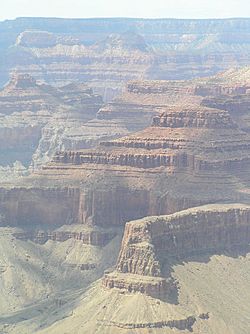Redwall Limestone facts for kids
Quick facts for kids Redwall LimestoneStratigraphic range: Early and early Late Mississippian |
|
|---|---|

A tall cliff of Redwall Limestone in the Grand Canyon. Below it, you can see the Muav Limestone.
|
|
| Type | Geological formation |
| Underlies | Surprise Canyon Formation (Surprise Canyon Formation locally fills paleovalleys, caves, and collapse structures cut into the underlying Redwall Limestone.) |
| Overlies | Muav Limestone and Temple Butte Formation |
| Thickness | 800 feet (240 m), at maximum |
| Lithology | |
| Primary | fossiliferous limestone |
| Other | dolomite and chert |
| Location | |
| Region | Northern Arizona, southeast California, New Mexico, and southern Utah, Nevada |
| Country | United States of America |
| Type section | |
| Named for | the red appearance of its escarpment on either side of the Grand Canyon |
| Named by | Gilbert (1875) |
The Redwall Limestone is a very strong rock layer. It forms tall, red-colored cliffs in the famous Grand Canyon. These cliffs can be from 500 feet (about 152 meters) to 800 feet (about 244 meters) high! This rock layer formed a long, long time ago, during the Mississippian period.
Contents
What is Redwall Limestone Made Of?
The Redwall Limestone is mostly made of a rock called limestone. This limestone is usually light gray and can have many different textures. It often contains pieces of a mineral called chert.
The lower parts of the Redwall Limestone also have brownish-gray dolomite. This dolomite is mixed with limestone layers. You might also find white chert lenses and thick layers of fine-grained dolomite.
Parts of the Redwall Limestone
Scientists have divided the Redwall Limestone into four main parts. These parts are called:
- Horseshoe Mesa Member
- Mooney Falls Member
- Thunder Springs Member
- Whitmore Wash Member
All these parts formed during the Mississippian age.
How the Redwall Limestone Connects to Other Rocks
The Redwall Limestone sits between other rock layers. Both its top and bottom surfaces are "unconformities." This means there are gaps in the rock record, showing that time passed or erosion happened before the next layer formed.
The Bottom Layer
Sometimes, the Redwall Limestone sits directly on a layer of conglomerate. This conglomerate is a rock made of gravel pieces. These gravel pieces often came from the rocks below it.
The Redwall Limestone usually rests on two older rock layers:
- The Temple Butte Formation: This is a thin layer of Devonian rock. It fills old valleys that were cut into the rock below.
- The Muav Limestone: This is a Cambrian rock layer. Where the Temple Butte Formation isn't present, the Redwall Limestone sits directly on the Muav Limestone.
The Top Layer
The top of the Redwall Limestone also shows signs of being worn away. It has deep, old valleys and sinkholes. These features are called "paleovalleys" and "paleokarst." These old valleys and sinkholes are often filled with sediments from the Surprise Canyon Formation.

